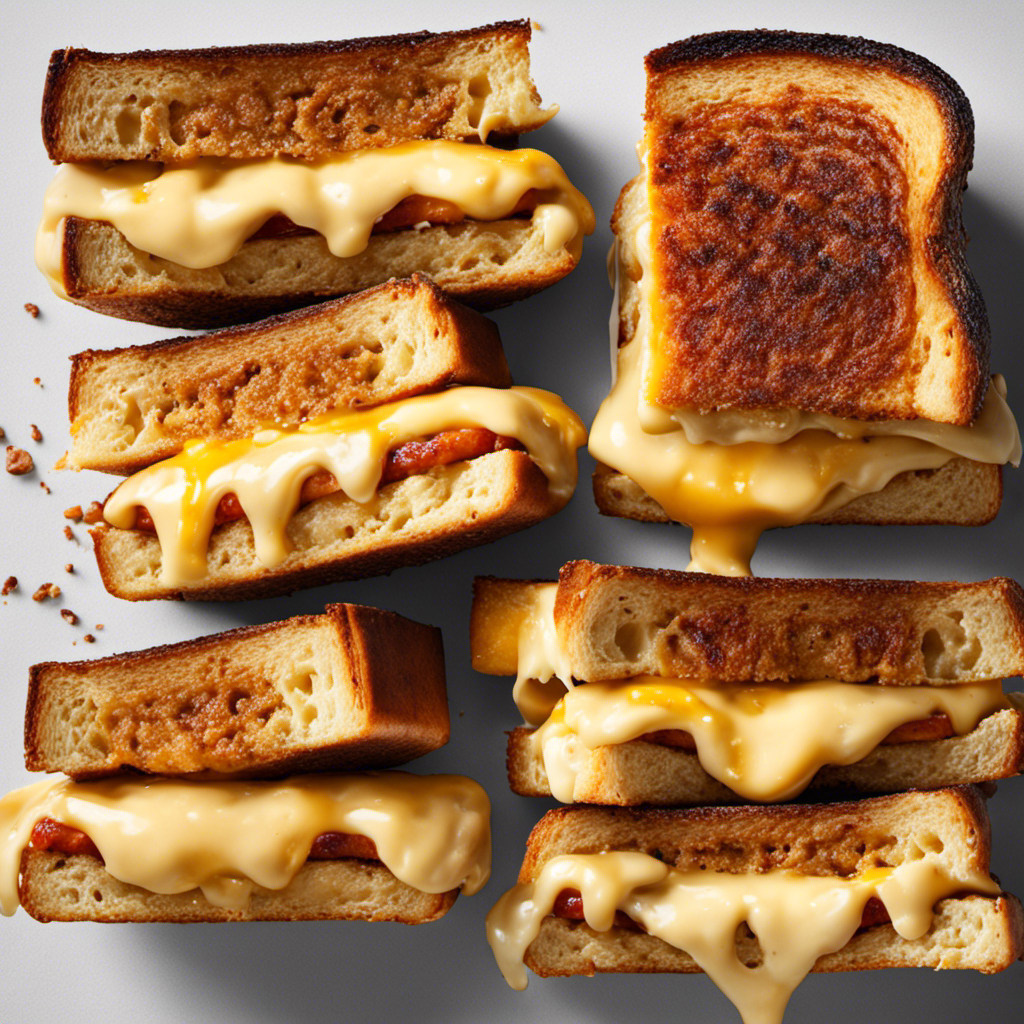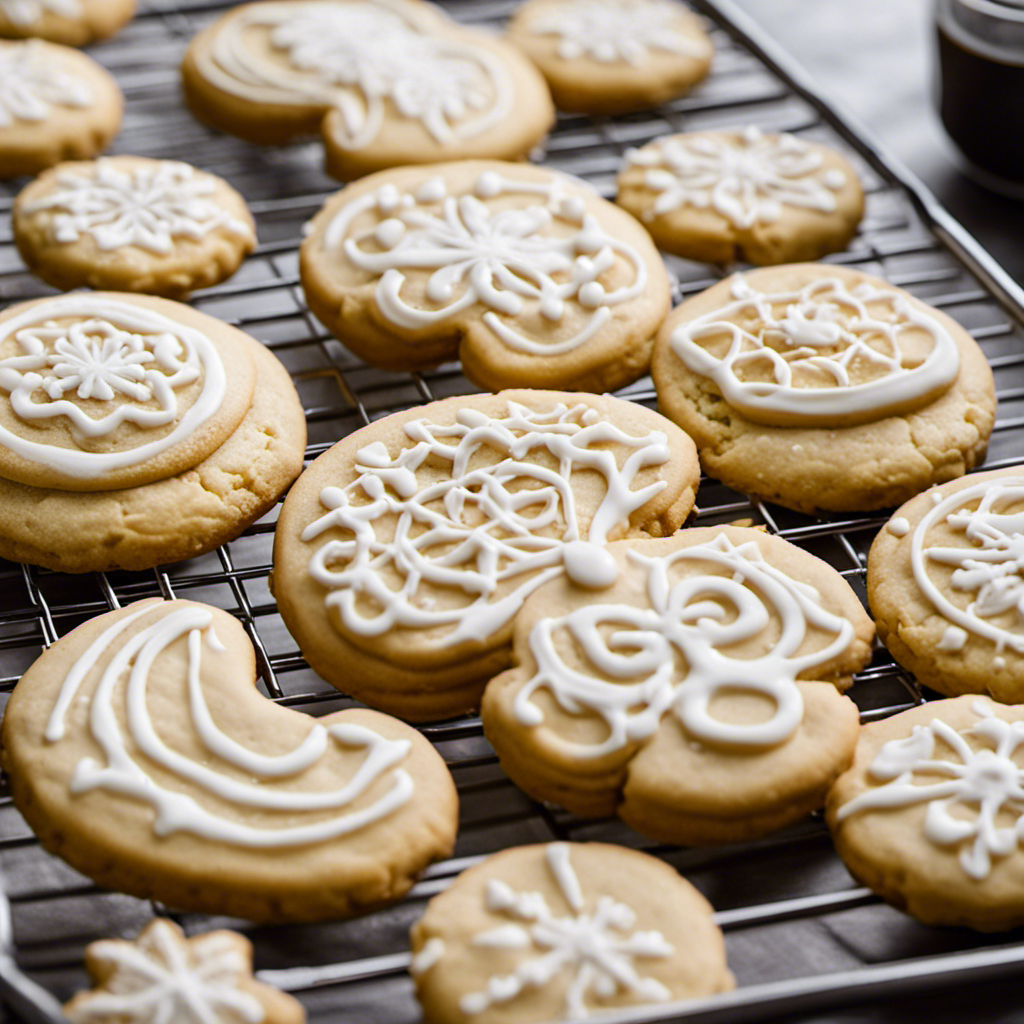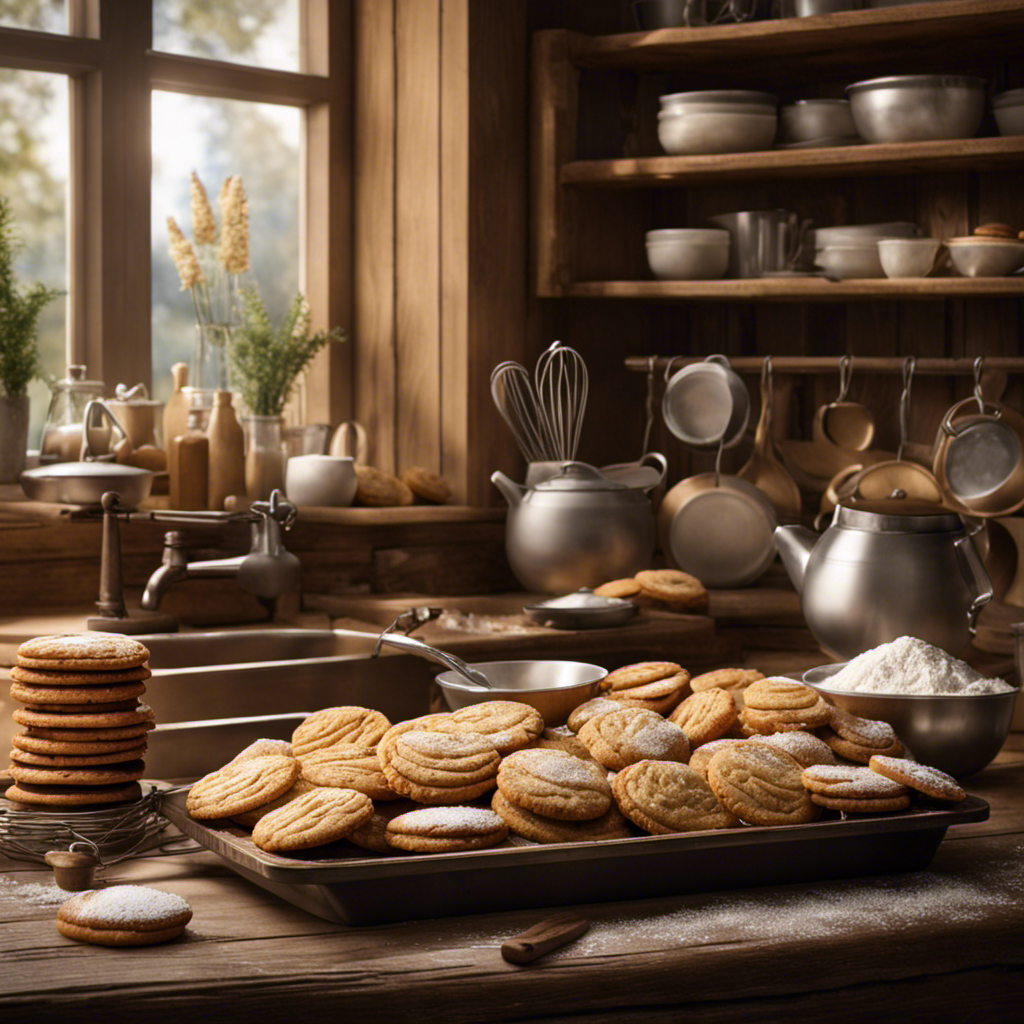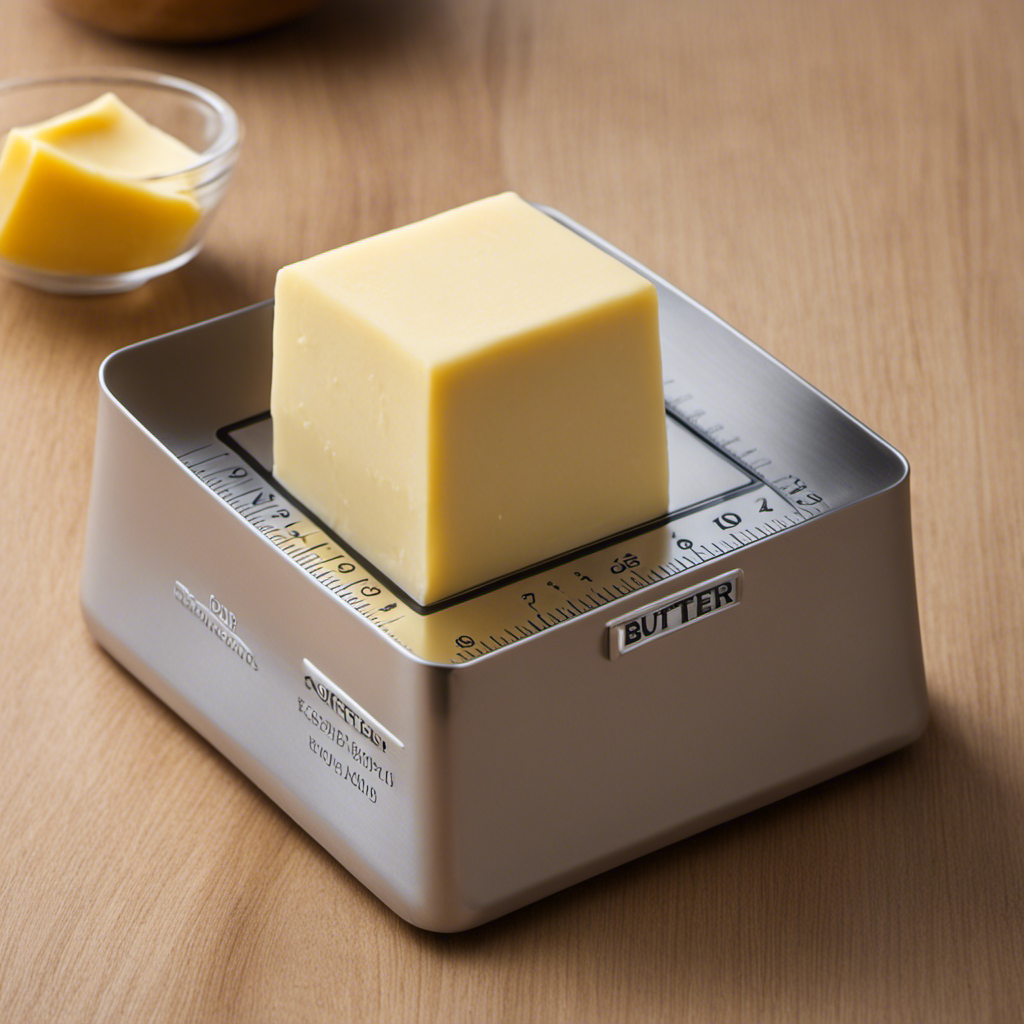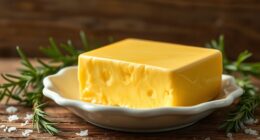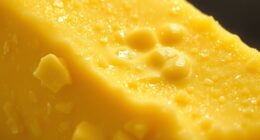I enjoy a tasty grilled cheese sandwich, but there are times when I run out of butter. That’s when I learned how to make a yummy grilled cheese without butter. Believe me, it’s doable and just as satisfying.
In this article, I’ll share with you my secrets for choosing the right cheese, exploring alternative spreads, and achieving that perfect golden brown crust. Get ready to elevate your grilled cheese game without a single pat of butter.
Key Takeaways
- Use alternative spreads like avocado, pesto, hummus, or tomato for added flavor and creaminess.
- Experiment with different cheese types and combinations to create unique and delicious grilled cheese sandwiches.
- Enhance the flavor of the bread by using mayonnaise or olive oil instead of butter and adding spices like smoked paprika, garlic powder, or dried herbs.
- Try butterless cheese melting techniques such as using mayonnaise, olive oil, mashed avocado, cream cheese, or pesto to achieve a crispy texture and burst of flavor.
The Importance of Choosing the Right Cheese
When making a grilled cheese without butter, it’s crucial to choose the right cheese for maximum flavor. As a cheese enthusiast, I understand the importance of selecting the perfect cheese substitute.
There are numerous options available, allowing you to experiment and find the one that suits your taste buds. For a creamy and melty texture, I recommend using mozzarella or Monterey Jack. These cheeses have a mild flavor that complements the crispy bread perfectly.
If you prefer a stronger taste, try using cheddar or Gouda. These cheeses add a bold and tangy flavor to your grilled cheese sandwich. Don’t be afraid to get creative and mix different cheese types to find your ultimate combination.
Exploring Alternative Spreads for Grilled Cheese
Instead of using butter, you can try using alternative spreads for your grilled cheese. These spreads not only add a unique flavor to your sandwich, but they also provide a healthier option. Here are some creative ingredient combinations that you can use as spreads for your grilled cheese:
| Spread | Flavor | Ingredient Combinations |
|---|---|---|
| Avocado Spread | Creamy and rich | Avocado, lime juice, salt |
| Pesto Spread | Herbaceous | Basil, pine nuts, garlic |
| Hummus Spread | Savory and tangy | Chickpeas, tahini, lemon juice |
| Tomato Spread | Tangy and refreshing | Tomatoes, garlic, olive oil |
These alternative spreads can be easily spread on your bread slices before grilling your cheese. They not only enhance the taste but also provide additional nutrients. So, get creative with your grilled cheese by trying out these alternative spreads and enjoy a delicious and healthier sandwich.
Preparing the Bread for the Perfect Grilled Cheese
When it comes to making a grilled cheese sandwich without butter, there are plenty of alternative options for the bread that can enhance both the flavor and texture.
One option is to use mayonnaise instead of butter to achieve that crispy and golden-brown exterior.
Another alternative is to brush the bread with olive oil, which adds a delicious richness to the sandwich.
Additionally, using a non-stick cooking spray can also help in achieving that desired crunch without the need for butter.
Butterless Bread Alternatives
You can use mayonnaise as a butterless alternative for spreading on the bread. Mayonnaise may seem like an unconventional choice, but it works wonders when it comes to grilling the perfect cheese sandwich.
Simply spread a thin layer of mayonnaise on the outer sides of the bread slices before placing them in the pan. The mayonnaise creates a crispy and golden crust, just like butter would.
Another option is using olive oil as a butterless spread. Brush a little olive oil on both sides of the bread for a deliciously crispy texture.
Additionally, you can try using avocado as a bread alternative. Mash a ripe avocado and spread it on the bread, adding a creamy and healthy twist to your grilled cheese sandwich.
Enhancing Flavor and Texture
To enhance the flavor and texture of your sandwich, try adding different spices and seasonings to the filling. This will not only elevate the taste but also make your sandwich more exciting and enjoyable. Here are some flavorful seasonings that you can experiment with:
- Smoked paprika: adds a subtle smoky flavor that complements the cheese perfectly.
- Garlic powder: gives a savory kick and enhances the overall taste.
- Dried herbs (such as basil, oregano, or thyme): adds freshness and complexity.
- Red pepper flakes: adds a touch of heat for those who like a little spice.
- Onion powder: adds a hint of sweetness and depth of flavor.
In addition to the seasonings, don’t forget to focus on achieving a crispy crust. Toasting your sandwich in a hot skillet or using a panini press will help create that perfect crunch.
The Art of Melting Cheese Without Butter
When it comes to making a grilled cheese sandwich without butter, there are a few techniques that can help achieve that perfectly melted cheese.
One option is to use mayonnaise instead of butter to spread on the bread before grilling.
Another alternative is to use olive oil or cooking spray to lightly coat the bread and prevent it from sticking to the pan.
Exploring these butterless cheese melting techniques opens up a world of possibilities for creating delicious grilled cheese sandwiches in a healthier and more creative way.
Butterless Cheese Melting Techniques
There’s a trick to melt the cheese without using butter in your grilled cheese sandwich. As someone who loves experimenting with different cooking methods, I’ve discovered alternative cheese options and techniques that still give you that gooey, melty goodness.
Here are some of my favorite ways to achieve the perfect butterless cheese melt:
-
Use mayonnaise: Spread a thin layer of mayo on the outside of your bread before grilling. It adds a tangy flavor and helps achieve a crispy golden crust.
-
Try olive oil: Brushing olive oil on the bread instead of butter creates a deliciously crispy texture and adds a subtle hint of flavor.
-
Use avocado: Mash up some avocado and spread it on the bread. It not only provides a creamy texture but also adds a healthy twist.
-
Use cream cheese: Spread a thin layer of cream cheese on the inside of the bread. It melts beautifully and adds a creamy richness to the sandwich.
-
Use pesto: Spread a thin layer of pesto on the inside of the bread for a burst of flavor and a unique twist on the classic grilled cheese.
With these alternative options, you can enjoy a deliciously melty grilled cheese sandwich without using butter. So go ahead, get creative and explore new ways to satisfy your cheesy cravings!
Alternative Grilled Cheese Methods
One option for achieving a gooey, melty grilled cheese sandwich without butter is by using alternative cheese melting techniques.
When it comes to alternative grilling methods, there are plenty of options that can create a delicious vegan grilled cheese.
One popular method is using a non-stick pan and cooking spray to prevent sticking and create a crispy exterior.
Another option is grilling the sandwich on a panini press, which provides even heat distribution and creates those coveted grill marks.
Additionally, using a grill pan or a cast iron skillet can also give the sandwich a nice charred flavor.
These alternative grilling methods not only offer a healthier option but also cater to those following a vegan diet.
Now, let’s explore how to enhance the flavor with seasonings and herbs.
Enhancing the Flavor With Seasonings and Herbs
To enhance the flavor of your grilled cheese without butter, try adding a pinch of garlic powder and a sprinkle of dried oregano. These seasoning options can take your sandwich to the next level and add a burst of aromatic flavors.
Here are some herb combinations you can experiment with to create a delicious twist on your grilled cheese:
- Fresh basil and sliced tomatoes for a Caprese-inspired sandwich
- Rosemary and thyme for a savory and earthy flavor
- Dill and lemon zest for a tangy and refreshing taste
- Smoked paprika and cayenne pepper for a spicy kick
- Cilantro and lime juice for a zesty and vibrant twist
By incorporating these herbs and spices, you can elevate the taste of your grilled cheese without relying on butter.
Now, let’s move on to adding extra crunch to your sandwich.
Adding Extra Crunch to Your Grilled Cheese
For an added crunch in your grilled cheese, try using a different type of bread like sourdough or ciabatta. These breads have a sturdy texture and crust that enhances the crunchiness of your sandwich. When choosing a bread, make sure it’s thickly sliced to provide a satisfying bite.
Another way to enhance the crunchiness is by experimenting with toppings. One option is to sprinkle some grated Parmesan cheese on the outside of the bread before grilling it. The cheese will melt and crisp up, creating a delicious crust. You can also try adding crushed potato chips or panko breadcrumbs to the cheese filling for an extra crunch.
These toppings not only add texture but also bring unique flavors to your grilled cheese. So, don’t be afraid to get creative and elevate your grilled cheese game with some satisfying crunchiness.
Mastering the Flip: Tips for a Perfectly Cooked Sandwich
When it comes to cooking the perfect sandwich, two key factors to consider are flip timing for doneness and achieving even browning.
Knowing when to flip your sandwich is crucial for ensuring that it is cooked to perfection, with a crispy exterior and a gooey, melted interior.
Additionally, achieving even browning is important for both the visual appeal and the taste of your sandwich, as it adds a delicious caramelized flavor.
In this discussion, I will share some expert tips on how to master the flip and achieve that perfectly cooked, evenly browned sandwich.
Flip Timing for Doneness
The key to achieving the perfect doneness for your grilled cheese is knowing when to flip it. Timing is everything when it comes to achieving that golden, crispy exterior and gooey, melted interior.
Here are a few tips to help you master the flip timing and achieve even browning:
-
Pay attention to the color and texture of the bread. Once it turns a deep golden brown and feels crispy to the touch, it’s time to flip.
-
Use a spatula to gently lift one corner of the sandwich to check the browning. If it’s not quite there yet, give it a little more time.
-
Listen for the sizzling sound. As the cheese starts to melt and bubble, it’s a good indication that the sandwich is ready to be flipped.
-
Watch for any oozing cheese. If you notice the cheese starting to melt out of the sides, it’s a sign that the sandwich is ready to be flipped.
-
Trust your instincts. With practice, you’ll develop a feel for when the sandwich is perfectly cooked on one side and ready to be flipped.
Achieving Even Browning
Achieving even browning on your grilled cheese sandwich is all about paying attention to the color and texture of the bread. The key is to achieve a beautiful golden brown crust without burning the bread.
One way to achieve this is by using alternative browning methods. For example, you can try using a non-stick pan and cooking your sandwich over medium heat. This will allow the bread to slowly toast and develop a nice, even color.
Another option is experimenting with different cheeses. Some cheeses, like cheddar or Gruyere, tend to brown better than others. By trying out different types of cheeses, you can find the perfect combination that results in an evenly browned sandwich.
Now, let’s explore how to achieve a golden brown crust without butter.
Achieving a Golden Brown Crust Without Butter
To achieve a golden brown crust without butter, you can use mayonnaise instead. Mayonnaise contains oil, which helps to create a crispy and flavorful crust on your grilled cheese sandwich. Here are some tips to achieve the perfect golden brown crust without butter:
- Spread a thin layer of mayonnaise on the outside of the bread slices before grilling.
- Use a non-stick pan or griddle to prevent the sandwich from sticking.
- Cook the sandwich over medium-low heat to ensure even browning.
- Flip the sandwich halfway through cooking to brown both sides evenly.
- Press the sandwich down gently with a spatula to create a crispy texture.
In addition to mayonnaise, you can also try using alternative cooking oils like olive oil or avocado oil to achieve a golden brown crust. For vegan options, there are plenty of delicious vegan cheese alternatives available that melt well and provide a creamy texture. Experiment with different combinations to find your perfect grilled cheese without butter.
Creative Ingredient Combinations for Unique Grilled Cheese
For a unique twist on your grilled cheese, try experimenting with different ingredient combinations to create a one-of-a-kind flavor experience. When exploring unconventional cheeses, think beyond the classic cheddar or American and consider brie, goat cheese, or even blue cheese for a tangy kick. These cheeses can add a new dimension to your grilled cheese and elevate it to a gourmet level.
Additionally, don’t be afraid to step outside the box when it comes to bread. Instead of the usual white or wheat, try using sourdough, rye, or even croissants for a buttery, flaky texture. The possibilities are endless when it comes to creating a unique grilled cheese masterpiece.
Now, let’s move on to serving and pairing suggestions for your grilled cheese.
Serving and Pairing Suggestions for Your Grilled Cheese
Now that you have your unique grilled cheese masterpiece, let’s talk about how to serve and pair it for the ultimate flavor experience. Here are some serving suggestions and cheese pairing ideas to take your grilled cheese to the next level:
- Serve your grilled cheese with a side of tomato soup for a classic and comforting combination.
- Add some sliced avocado and bacon to your grilled cheese for a delicious twist.
- Pair your grilled cheese with a crisp and refreshing salad for a light and balanced meal.
- Serve your grilled cheese with a side of pickles or pickled vegetables for a tangy and crunchy contrast.
- Pair your grilled cheese with a glass of red wine or a hoppy beer to complement the rich, cheesy flavors.
Troubleshooting Common Issues With Butter-Free Grilled Cheese
If your butter-free grilled cheese is turning out dry, try using a different type of cheese or adding a spread for moisture. Troubleshooting sandwich consistency is important to achieve the perfect grilled cheese sandwich. One common issue with butter-free grilled cheese is that it can turn out dry. To combat this, try using a cheese that melts well, such as mozzarella or cheddar. These cheeses have a higher moisture content and will help keep your sandwich moist. Another option is to add a spread to the bread, such as mayonnaise or olive oil, before grilling. This will give the sandwich a nice, crispy exterior while maintaining moisture on the inside. Additionally, consider alternatives to traditional bread, like using whole wheat or sourdough bread, which can add more flavor and texture to your grilled cheese.
To further assist you in troubleshooting sandwich consistency, below is a helpful table that outlines some common issues and their solutions:
| Problem | Possible Solution |
|---|---|
| Dry sandwich | Use a cheese with higher moisture content, such as mozzarella or cheddar. Add a spread to the bread before grilling, such as mayonnaise or olive oil. |
| Cheese not melting properly | Use a cheese that melts well, such as mozzarella or cheddar. Ensure that the heat is evenly distributed throughout the pan or griddle. |
| Burnt bread | Adjust the heat to medium-low and keep a close eye on the sandwich to prevent burning. Use a non-stick pan or griddle to avoid sticking. |
| Sandwich not crispy | Use a spread with a high smoke point, such as clarified butter or vegetable oil. Ensure that the heat is evenly distributed throughout the pan or griddle. |
| Limp sandwich | Cook the sandwich for a longer period of time, ensuring that both sides are evenly browned and crispy. Use a cheese with a higher melting point, such as Swiss or Gruyere. |
Frequently Asked Questions
Can I Use Any Type of Cheese for a Butter-Free Grilled Cheese Sandwich?
Yes, you can use vegan cheese for a butter-free grilled cheese sandwich. Some healthy alternatives to butter for a grilled cheese include avocado, olive oil, or mayonnaise. They provide a tasty and nutritious twist to your sandwich.
What Are Some Alternative Spreads That Can Be Used Instead of Butter for a Grilled Cheese?
When making a grilled cheese without butter, there are several alternative spreads you can use. Some options include mayo, olive oil, or avocado. These spreads can add flavor and help achieve a crispy bread texture.
How Can I Make the Bread Crispy Without Using Butter?
To make the bread crispy without using butter, I would recommend using mayonnaise as an alternative spread. Simply spread a thin layer on the bread before grilling for a delicious and crispy grilled cheese sandwich.
Are There Any Specific Seasonings or Herbs That Work Best for Enhancing the Flavor of a Butter-Free Grilled Cheese?
There are several seasonings and herbs that can enhance the flavor of a butter-free grilled cheese. Some of the best cheese alternatives and techniques for achieving a golden crust are worth exploring.
What Are Some Creative Ingredient Combinations That Can Be Used to Make Unique Grilled Cheese Sandwiches Without Butter?
Can I use oil as an alternative to butter for a grilled cheese sandwich? Absolutely! And when it comes to creative ingredient combinations for unique grilled cheese sandwiches without butter, the possibilities are endless. Let me share some of my favorites.
Conclusion
As I take my final bite of this delicious butter-free grilled cheese, I can’t help but feel a sense of accomplishment.
Who knew that a simple sandwich could be so satisfying without the traditional butter?
By exploring alternative spreads, melting cheese just right, and adding the perfect seasonings, I have unlocked a whole new world of grilled cheese possibilities.
So, my fellow cheese enthusiasts, don’t be afraid to experiment and think outside the butter box.
Your taste buds will thank you for it.
Now, go forth and grill!
